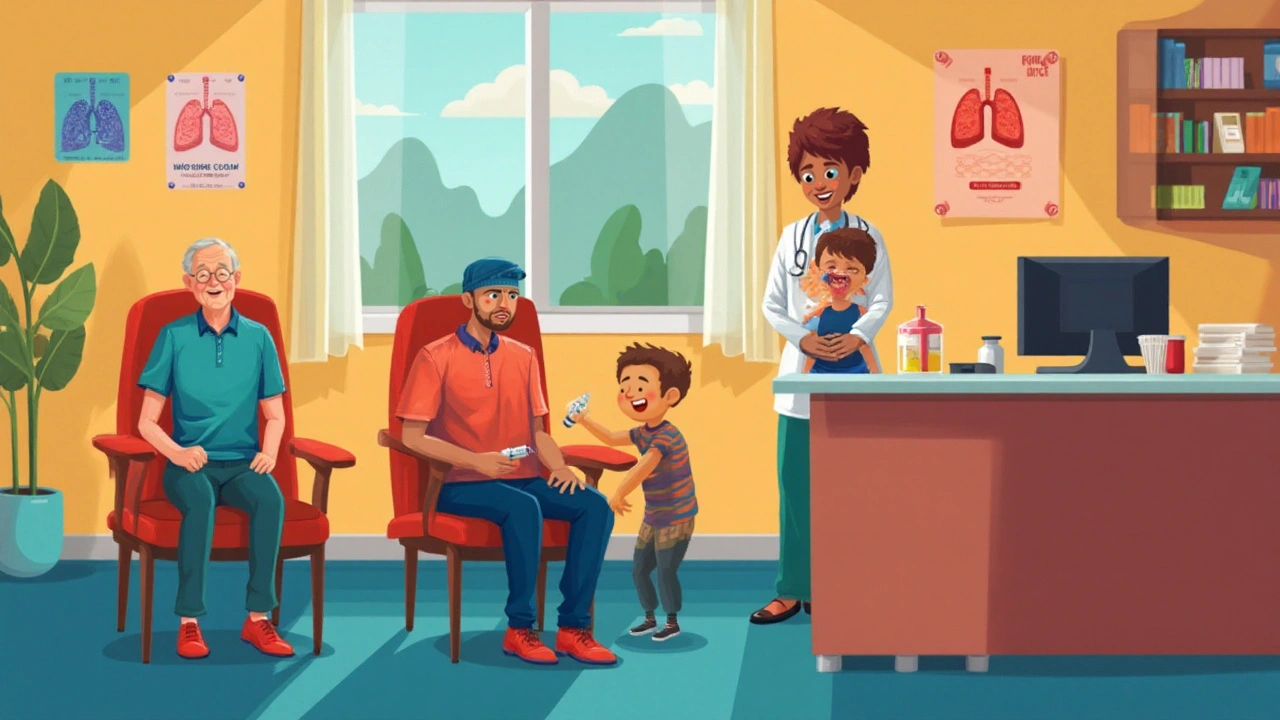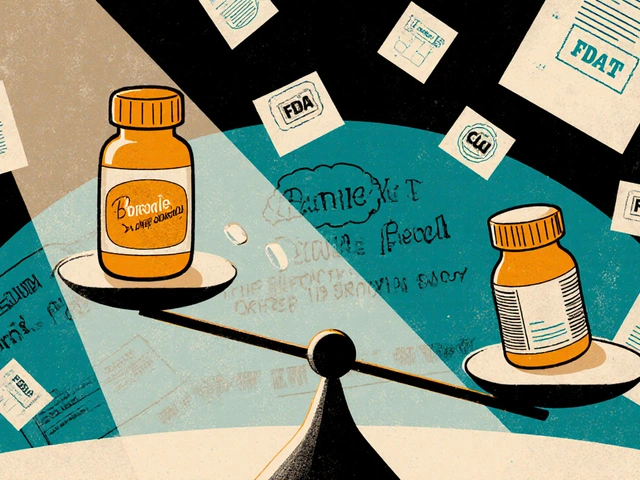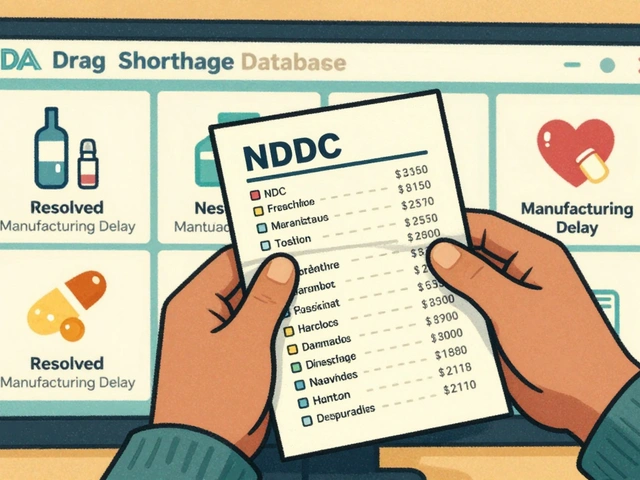
Pneumonia is an inflammatory lung infection that fills air sacs with fluid or pus, causing cough, fever, and breathing difficulty. While any pathogen can trigger it, a large share of cases follow an influenza (flu) episode. Understanding that connection helps you spot warning signs early and act before the disease spirals.
Why the Flu Sets the Stage for Pneumonia
The flu attacks the respiratory epithelium, stripping away the protective mucus layer and weakening cilia that normally sweep germs out. This damage creates a doorway for secondary invaders. In epidemiological surveys, the CDC reports that up to 30% of hospitalized flu patients develop secondary bacterial pneumonia, most often within a week of flu symptom onset.
Key Pathogens Behind Post‑Flu Pneumonia
Two bacteria dominate the scene:
- Streptococcus pneumoniae - responsible for classic lobar pneumonia, it accounts for roughly 45% of post‑influenza bacterial cases.
- Staphylococcus aureus - especially the methicillin‑resistant strain (MRSA), it tends to cause fast‑progressing, necrotizing pneumonia.
Less common culprits include Haemophilus influenzae and atypical organisms like Mycoplasma pneumoniae, but the two listed above are the heavy hitters.
Risk Factors: Who’s Most Vulnerable?
Not everyone with the flu gets pneumonia. Certain groups face a markedly higher chance:
| Factor | Impact on Risk | Typical Example |
|---|---|---|
| Age > 65 | 2-3× higher | Retired adults with chronic heart disease |
| Chronic lung disease | 1.8× higher | Asthma or COPD patients |
| Immunosuppression | 3× higher | Chemotherapy patients |
| Smoking | 1.5× higher | Current daily smokers |
| Pregnancy (third trimester) | 1.4× higher | Expectant mothers |
Underlying heart disease, diabetes, and recent hospitalization also tip the scales. If you belong to any of these categories, proactive prevention becomes essential.
Prevention: Vaccines, Antivirals, and Everyday Hygiene
The most powerful shield is the influenza vaccine. The WHO estimates that global vaccination prevents 290,000 hospitalizations from flu‑related pneumonia each year. Even when the strain isn’t a perfect match, the vaccine still reduces severity, buying time for the immune system.
When flu symptoms appear, early treatment with antiviral medication (e.g., oseltamivir) cuts viral replication by up to 70%, shortening illness by about 1‑2 days. Studies from the CDC show that patients who start antivirals within 48hours have a 40% lower chance of progressing to pneumonia.
Hand washing, mask use during outbreaks, and avoiding crowded indoor spaces are low‑cost habits that dramatically lower viral exposure.
Diagnosis: Spotting the Transition Early
Clinicians rely on a combination of clinical judgment and tests. Key red flags indicating a shift from flu to pneumonia include:
- Persistent or worsening fever beyond 5days
- New onset of productive cough with purulent sputum
- Shortness of breath at rest
- Chest pain that worsens with deep breaths
Chest X‑ray confirms infiltrates, while sputum culture identifies the bacterial culprit. In doubtful cases, a rapid urinary antigen test for Streptococcus pneumoniae can speed up targeted therapy.

Treatment Pathways: From Antivirals to Antibiotics
If viral pneumonia is the primary problem (rare but possible with H1N1, H5N1), supportive care-oxygen, fluids, and sometimes corticosteroids-remains the backbone. However, most post‑flu pneumonias are bacterial, so prompt antibiotic therapy is critical.
Empiric regimens often start with a high‑dose beta‑lactam (e.g., ceftriaxone) plus a macrolide to cover atypical organisms. If MRSA is suspected, vancomycin or linezolid is added. The Infectious Diseases Society of America (IDSA) recommends a 5‑7day course for uncomplicated cases, extending to 2weeks for severe or immunocompromised patients.
Monitoring vital signs, repeat imaging, and laboratory markers (CRP, procalcitonin) guides the switch from IV to oral antibiotics and signals when it’s safe to discharge.
Comparing Influenza and Pneumonia
| Aspect | Influenza (Flu) | Pneumonia |
|---|---|---|
| Primary Cause | Influenza virus (RNA orthomyxovirus) | Various pathogens (bacterial, viral, fungal) |
| Typical Onset | Sudden, 1‑3days | Gradual or abrupt after a viral prodrome |
| Core Symptoms | Fever, chills, myalgia, dry cough | Productive cough, chest pain, dyspnea |
| Complications | Otitis media, sinusitis, pneumonia | Respiratory failure, sepsis, empyema |
| Treatment Focus | Antivirals & supportive care | Antibiotics (if bacterial) + supportive |
Understanding these distinctions helps patients and providers decide when a simple flu course is over and when aggressive pneumonia treatment is needed.
Real‑World Example: A Seasonal Outbreak
During the 2023‑2024 winter season, a Midwestern hospital reported 420 flu admissions. Of those, 118 (28%) progressed to pneumonia within a week. Most of the secondary infections were caused by Streptococcus pneumoniae, and 73% of the affected patients had received the flu shot. This illustrates that vaccination cuts risk but does not guarantee absolute protection-high‑risk patients still need close monitoring.
Bottom Line: Stay Ahead of the Curve
Linking flu to pneumonia isn’t just academic; it’s a practical roadmap for saving lives. Get vaccinated every fall, seek antivirals at the first sign of flu, watch for worsening symptoms, and don’t hesitate to get a chest X‑ray if you’re in a high‑risk group. Early action transforms a potentially deadly cascade into a routine recovery.
Frequently Asked Questions
Can the flu cause pneumonia in healthy adults?
Yes, but the risk is lower. Healthy adults usually clear the virus before bacteria can settle in. Still, about 5‑10% of otherwise fit people develop viral pneumonia directly from influenza.
How quickly can pneumonia develop after the flu starts?
Secondary bacterial pneumonia typically shows up 3‑7days after flu symptoms begin, often when fever spikes again or a new cough with colored sputum appears.
Is the flu vaccine effective against pneumonia?
The flu shot doesn’t prevent bacterial pneumonia directly, but it reduces flu severity and duration, which in turn lowers the chance of a secondary bacterial infection.
Should I take antibiotics if I have the flu?
No. Antibiotics target bacteria, not viruses. They’re only prescribed if a bacterial pneumonia is confirmed or strongly suspected after the flu.
What are the warning signs that flu has turned into pneumonia?
Look for a fever that returns after a brief dip, a cough that becomes productive with yellow/green sputum, shortness of breath at rest, and chest pain that worsens with deep breathing.
Are there specific antivirals that reduce pneumonia risk?
Oseltamivir and baloxavir are the main options. When started within 48hours of flu onset, they cut viral load and have been shown to lower secondary bacterial pneumonia rates by roughly 30‑40% in high‑risk groups.
Can COVID‑19 be confused with flu‑related pneumonia?
Both can cause viral pneumonia and share symptoms like fever and cough. Testing for SARS‑CoV‑2, influenza, and bacterial pathogens is essential to differentiate and guide treatment.




Megan Lallier-Barron
September 25, 2025 AT 00:52Flu‑to‑pneumonia link? Just another reminder that nature loves drama 🤷♀️
Kelly Larivee
September 27, 2025 AT 21:06Thanks for the rundown, it's good to know when to get extra care.
Emma Rauschkolb
September 30, 2025 AT 18:33When the influenza virus breaches the epithelial barrier, it initiates a cascade of cytokine release that destabilizes the alveolar surfactant matrix. The compromised mucociliary clearance then creates a niche for opportunistic bacteria to adhere to the bronchiolar epitheli - especially Streptococcus pneumoniae, which possesses a polysaccharide capsule that evades phagocytosis. Concurrently, the viral neuraminidase exposure unmasks sialic acid receptors, enhancing bacterial docking sites. A surge in interleukin‑6 and tumor necrosis factor‑α amplifies vascular permeability, fostering exudative infiltrates that appear as radiographic opacities. In immunocompromised hosts, the adaptive immune response falters, delaying IgG‑mediated opsonization and prolonging bacteremia. Moreover, secondary bacterial pneumonia often presents with a biphasic fever pattern: an initial pyrexia from influenza followed by a resurgence as bacterial load climbs. Early antiviral therapy, such as oseltamivir, can truncate viral replication and indirectly diminish bacterial superinfection rates, yet it does not eradicate pre‑existing bacterial colonizers. Empiric antibiotic coverage should therefore be guided by local susceptibility patterns, with vancomycin reserved for suspected MRSA and ceftriaxone for typical pneumococcal strains. Monitoring biomarkers like procalcitonin can aid in distinguishing viral from bacterial etiologies, thereby optimizing antimicrobial stewardship. Lastly, vaccination strategies that incorporate both influenza and pneumococcal antigens synergistically lower the incidence of post‑viral pneumonia, especially in the elderly and chronically ill. 😊
Kaushik Kumar
October 3, 2025 AT 16:00Great summary! 👏 The key takeaway is that early antiviral treatment can literally save a life, especially for those with COPD or heart disease. 💪 If you’re over 65 or have diabetes, get that flu shot and keep a stash of oseltamivir on hand-talk to your doctor about a prescription. Remember, hand‑washing isn’t just a habit, it’s a frontline defense! And don’t forget to stay hydrated; fluids help thin mucus and improve clearance. If you notice a fever spike after a few days, that’s a red flag-seek medical care ASAP. Your immune system needs support, not just a band‑aid. Stay vigilant, stay healthy! 🌟
Mara Mara
October 6, 2025 AT 13:26The data clearly illustrate that vaccination is a patriotic duty; protecting our community reduces hospital burden and saves lives. It’s scientifically proven, not a political slogan. 🇺🇸
Jennifer Ferrara
October 9, 2025 AT 10:53Whilst revieiwng the insghts, I notice a few typographical overs ights, but the core message remains compelling and instructive.
Terry Moreland
October 12, 2025 AT 08:20I’ve seen a lot of people shrug off the flu, only to end up in the ER with pneumonia. It’s scary, but the good news is that quick action-antivirals, rest, and hydration-can keep it from spiraling. Stay aware of those warning signs.
Abdul Adeeb
October 15, 2025 AT 05:46The article correctly emphasizes the importance of early diagnostic imaging; a chest X‑ray remains the gold standard for confirming infiltrates. Precise terminology is essential.
Abhishek Vernekar
October 18, 2025 AT 03:13Got a feeling that many ignore the subtle shift from flu to pneumonia until it’s too late-let’s spread the word! 😔
Val Vaden
October 21, 2025 AT 00:40Looks like fluff.
lalitha vadlamani
October 23, 2025 AT 22:06While the statistics are certainly persuasive, one must also consider the moral implications of complacency in public health. Neglecting vaccination campaigns constitutes a dereliction of civic responsibility, especially when vulnerable populations are at stake. Thus, the righteous path is clear: endorse aggressive immunization policies.
kirk lapan
October 26, 2025 AT 18:33Honestly, the piece feels overrated; the mechanisms are textbook material and don’t warrant such fanfare.
Landmark Apostolic Church
October 29, 2025 AT 16:00From a philosophical standpoint, the flu‑pneumonia cascade exemplifies how small perturbations can trigger cascading failures in complex systems. It mirrors broader societal vulnerabilities.
Matthew Moss
November 1, 2025 AT 13:26It is imperative, therefore, that individuals adhere to prophylactic measures, for the sake of communal well‑being.
Antonio Estrada
November 4, 2025 AT 10:53Let’s add that consistent follow‑up appointments post‑influenza can catch secondary infections early, reducing morbidity.
Andy Jones
November 7, 2025 AT 08:20Wow, another post about flu and pneumonia-groundbreaking. 🙄
Kevin Huckaby
November 10, 2025 AT 05:46Wow, that’s 🔥!
Megan Lallier-Barron
November 13, 2025 AT 03:13🔥 Indeed, the details are sizzling, but let’s keep the discussion grounded.
Kaushik Kumar
November 16, 2025 AT 00:40Appreciate the enthusiasm-just remember that actionable steps matter more than hype.
Andy Jones
November 18, 2025 AT 22:06Sure, keep the pep talk coming while the rest of us wait for real new insights.